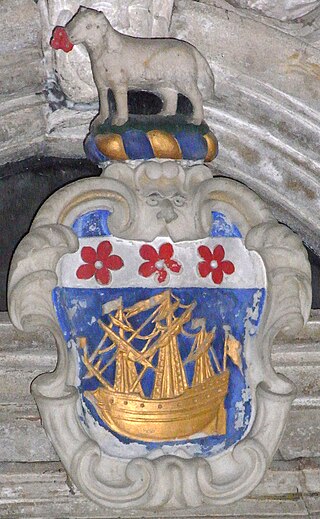
John Shore, 1st Baron Teignmouth, 1st Baronet was a British official of the East India Company who served as Governor-General of Bengal from 1793 to 1798. In 1798 he was created Baron Teignmouth in the Peerage of Ireland. Shore was the first president of the British and Foreign Bible Society. A close friend of the orientalist Sir William Jones (1746–1794), Shore edited a memoir of Jones's life in 1804, containing many of Jones's letters.
Rajmahal is a subdivisional town and a notified area in Rajmahal subdivision of the Sahebganj district in the Indian state of Jharkhand. It is situated at the banks of Ganges and was former capital of Bengal Subah under Mughal governor, Man Singh I.

Thomas Daniell was an English landscape painter who also painted Orientalist themes. He spent seven years in India, accompanied by his nephew William, also an artist, and published several series of aquatints of the country.

Mirza Asaf-ud-Daula was the Nawab wazir of Oudh ratified by Shah Alam II, from 26 January 1775 to 21 September 1797, and the son of Shuja-ud-Dowlah. His mother and grandmother were the Begums of Oudh.

Sir George Augustus William Shuckburgh-Evelyn, 6th Baronet was a British politician, mathematician and astronomer.

William Wither Bramston Beach was an English Conservative politician, who served in the House of Commons for 44 years between 1857 and 1901, becoming Father of the House of Commons in 1899.
The Ṣadr Dīwānī ʿAdālat was the Supreme Court of Revenue in British India established at Calcutta by Warren Hastings in 1772. It was reformed in 1780 and again in 1793 by the British Parliament. The court's judges were the Governor General and Council Members of the East India Company, assisted by native judges and officers of revenue.

Tilka Majhi was an Indian freedom fighter the first adivasi leader from Santal community. He took up arms against the British in the 1784, around 70 years before Mangal Pandey. He organized the adivasis to form an armed group to fight against the resource grabbing and exploitation of British.

William Langham Christie of Glyndebourne, Sussex, and Tapeley, North Devon, was a British Conservative Party politician.

South Park Street Cemetery, formerly known as the 'Great Christian Burial Ground', was one of the earliest non-church cemeteries in the world. The cemetery houses numerous graves and monuments belonging to British soldiers, administrators, and their families. It is also the final resting place of several prominent personalities, including Henry Louis Vivian Derozio and Sir William Jones. It is located on Mother Teresa Sarani, Central Kolkata, India.
John Clevland,, of Tapeley in the parish of Westleigh, North Devon, was Secretary to the Admiralty and was twice a Member of Parliament for Saltash in Devon and for Sandwich in Kent.

John Davie (1640–1710) of Orleigh Court in the parish of Buckland Brewer, Devon, England, was a prominent tobacco merchant from Bideford, Devon. His Bideford town house which he built in 1688, was Colonial House, now the Royal Hotel, in which survive several 17th-century decorative plasterwork ceilings, said by Pevsner & Cherry (2004) to be amongst the best in Devon, and a grand staircase.

Tapeley is a historic estate in the parish of Westleigh in North Devon, England.

St. John's Church, originally a cathedral, was among the first public buildings erected by the East India Company after Kolkata (Calcutta) became the effective capital of British India. It is located at the North-Western corner of Raj Bhavan, and served as the Anglican Cathedral of Calcutta till 1847, when the see was transferred to St. Paul's Cathedral. Construction of the building, modelled on St Martin-in-the-Fields of London, started in 1784, with Rs 30,000 raised through a public lottery, and was completed in 1787. The land the church stands on was gifted by Maharaja Nabo Kishen Bahadur of Sobhabazar. It is the third oldest church in the city, next to the Armenian Church of the Holy Nazareth and the Old Mission Church.

Captain William Clevland (1664–1734), of Tapeley in the parish of Westleigh, North Devon, was a Scottish-born Royal Navy commander who served as Controller of Storekeepers' Accounts. In 1704, he purchased the estate of Tapeley which today is still owned and occupied by his descendants the Christie family, also of Glyndebourne House, East Sussex.

John II Clevland of Tapeley in the parish of Westleigh, Devon, was seven times Member of Parliament for Barnstaple from 1766 to 1802.
The following is based on a glossary attached to the fifth Report of the Committee of the House of Commons on Indian affairs, appointed in 1810, comprising Hindustani words commonly used in the administration of the British Raj.
Samuel Davis (1760–1819) was an English soldier turned diplomat who later became a director of the East India Company (EIC). He was the father of John Francis Davis, one time Chief Superintendent of British Trade in China and second governor of Hong Kong.
John Herbert Harington was a British orientalist, colonial administrator and judge. He published a two-volume edition of the Arabic and Persian works of Saadi Shirazi.















